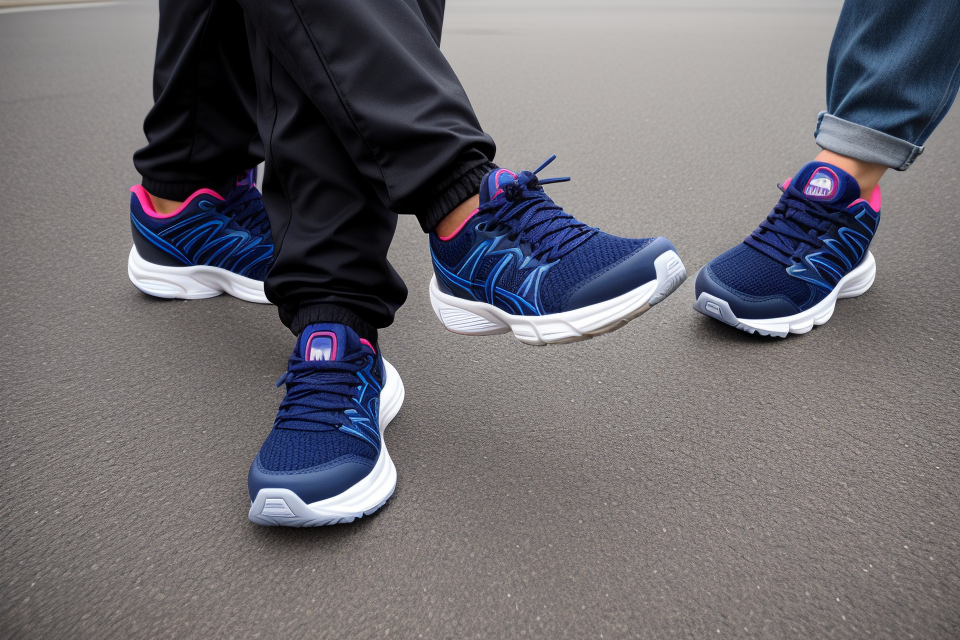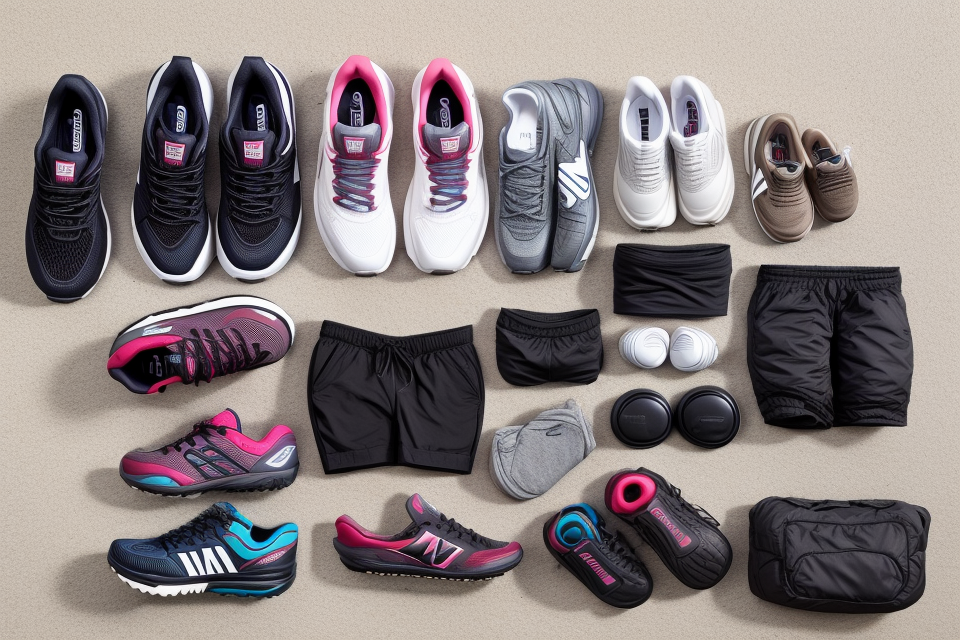If you’re one of the millions of people who suffer from plantar fasciitis, you know how debilitating the pain can be. You may have heard that wearing shoes all the time is the best way to alleviate the pain, but is that really true? In this comprehensive guide, we’ll explore the pros and cons of wearing shoes with plantar fasciitis, and give you the information you need to make an informed decision about your footwear. Whether you’re a seasoned athlete or just dealing with occasional pain, this guide has something for everyone. So let’s get started and navigate the world of footwear with plantar fasciitis!
Understanding Plantar Fasciitis
Causes and Symptoms
Plantar fasciitis is a common condition that affects the foot and ankle, resulting in heel pain and discomfort. The plantar fascia is a thick band of tissue that runs along the bottom of the foot, connecting the heel bone to the toes. When this tissue becomes inflamed or irritated, it can cause pain and discomfort, particularly in the heel and arch of the foot.
Common symptoms of plantar fasciitis include:
- Heel pain, which may be worse in the morning or after sitting or standing for long periods of time
- Pain or discomfort in the arch of the foot
- Swelling or tenderness in the heel or foot
- Difficulty walking or standing for long periods of time
- Pain that worsens with activity and improves with rest
It is important to note that plantar fasciitis is not caused by a single injury or event, but rather is the result of repetitive stress and overuse of the foot and ankle. Factors that may contribute to the development of plantar fasciitis include:
- Flat feet or high arches
- Being overweight or obese
- Having a tight Achilles tendon
- Engaging in activities that put repetitive stress on the foot and ankle, such as running or standing for long periods of time
- Having a history of foot or ankle injuries
If you are experiencing heel pain or discomfort, it is important to see a healthcare provider for an accurate diagnosis and appropriate treatment plan.
Risk Factors
- Certain professions: Individuals who are on their feet for extended periods of time, such as retail workers, teachers, and factory workers, are at a higher risk for developing plantar fasciitis. This is due to the repetitive stress placed on the foot and heel, which can cause inflammation and pain.
- Health conditions: Certain health conditions, such as obesity, high blood pressure, and diabetes, can increase the risk of developing plantar fasciitis. These conditions can cause additional stress on the foot and make it more difficult for the body to heal.
- Lifestyle factors: Certain lifestyle factors, such as a sedentary lifestyle, poor footwear choices, and a lack of stretching or exercise, can also increase the risk of developing plantar fasciitis. These factors can contribute to the development of flat feet, weak foot muscles, and other conditions that can lead to heel pain and inflammation.
Plantar Fasciitis Treatment Options
Non-Surgical Treatments
- Rest and ice: The first line of treatment for plantar fasciitis typically involves rest and ice therapy. Patients are advised to avoid activities that exacerbate their symptoms and to apply ice to the affected area for 15-20 minutes, several times a day, to reduce pain and inflammation.
- Physical therapy: Physical therapy can help stretch and strengthen the muscles in the foot and ankle, which can alleviate pain and improve mobility. A physical therapist may also recommend exercises to improve balance and stability, which can help prevent future injuries.
- Medications: Non-steroidal anti-inflammatory drugs (NSAIDs) such as ibuprofen or naproxen can help reduce pain and inflammation associated with plantar fasciitis. However, it is important to note that long-term use of these medications can have side effects and should be used under the guidance of a healthcare professional.
- Shockwave therapy: Shockwave therapy is a non-invasive treatment that uses high-energy sound waves to stimulate the healing process in the plantar fascia. This treatment is often used for chronic cases of plantar fasciitis that have not responded to other forms of treatment.
Surgical Treatments
When conservative treatments such as rest, ice, stretching, and physical therapy have not provided relief, surgery may be considered as a treatment option for plantar fasciitis. Surgery is typically reserved for severe cases of plantar fasciitis that have not responded to other treatments.
Types of surgery for plantar fasciitis include:
- Plantar fasciotomy: This is a surgical procedure that involves cutting the plantar fascia to release tension and relieve pain. There are two types of plantar fasciotomy:
- Lesser palmar fasciotomy: This procedure involves making a small incision in the foot and cutting the plantar fascia where it connects to the heel bone.
- Digger’s fasciotomy: This procedure involves making a larger incision in the foot and cutting the plantar fascia where it connects to the metatarsal bones.
- Gastrocnemius recession: This is a surgical procedure that involves releasing the gastrocnemius muscle, which is a large muscle in the back of the leg that can put tension on the plantar fascia. This procedure is typically performed on individuals who have a high arch or a tight Achilles tendon.
- Plantar fascia release: This is a surgical procedure that involves cutting the plantar fascia to release tension and relieve pain. This procedure is similar to a plantar fasciotomy, but the incision is made on the sole of the foot rather than on the heel.
It is important to note that surgery is a last resort treatment option for plantar fasciitis and should only be considered after conservative treatments have been tried and have not provided relief. Surgery carries risks such as infection, bleeding, and complications from anesthesia, so it is important to discuss the risks and benefits of surgery with a healthcare provider before making a decision.
The Role of Footwear in Plantar Fasciitis
Why Footwear Matters
Footwear plays a crucial role in managing plantar fasciitis, a common condition that affects the heel and bottom of the foot. Proper footwear can help reduce pain and inflammation, support the arch, and distribute pressure evenly. In this section, we will explore the reasons why footwear matters in the context of plantar fasciitis.
- Reducing pain and inflammation: Plantar fasciitis is characterized by inflammation and irritation of the plantar fascia, a band of tissue that runs along the bottom of the foot. The right footwear can help reduce pain and inflammation by providing cushioning, support, and shock absorption. Shoes with good arch support, a cushioned midsole, and a firm heel counter can help alleviate pain and prevent further injury.
- Supporting the arch: The arch of the foot is crucial in absorbing shock and maintaining balance. Flat feet or high arches can contribute to plantar fasciitis, and proper footwear can help support the arch. Shoes with a stable and supportive design, such as motion control or stability shoes, can help support the arch and reduce strain on the plantar fascia.
- Distributing pressure evenly: Plantar fasciitis is often caused by uneven pressure on the foot, particularly on the heel and arch. The right footwear can help distribute pressure evenly, reducing the risk of developing plantar fasciitis or worsening existing symptoms. Shoes with a wide toe box, a curved shape, and a soft and flexible sole can help distribute pressure evenly and prevent excessive pressure on the plantar fascia.
In conclusion, footwear plays a critical role in managing plantar fasciitis. Proper footwear can help reduce pain and inflammation, support the arch, and distribute pressure evenly. By choosing the right shoes, individuals with plantar fasciitis can improve their symptoms and prevent further injury.
Best Shoes for Plantar Fasciitis
When it comes to managing plantar fasciitis, footwear plays a crucial role. Wearing the right shoes can provide the necessary support, cushioning, and stability to alleviate pain and prevent further injury. Here are some features to look for when choosing the best shoes for plantar fasciitis:
- Support: Look for shoes with a sturdy and supportive build, preferably with a reinforced heel counter and a firm midsole. The shoe should be able to maintain its shape and provide ample support throughout the day.
- Cushioning: Opt for shoes with good cushioning in the heel and forefoot areas. This can help absorb the impact of each step and reduce the strain on the plantar fascia.
- Arch support: A shoe with a good arch support can help distribute body weight evenly and reduce the risk of overpronation, which is a common cause of plantar fasciitis.
- Non-slip sole: A non-slip sole can provide added stability and prevent slips and falls, which can exacerbate plantar fasciitis.
- Lightweight: Choose shoes that are lightweight and easy to wear, as heavy shoes can cause discomfort and fatigue.
Based on these features, here are some top shoe recommendations for plantar fasciitis:
- New Balance 990v5: This shoe offers excellent support and cushioning, with a stable and comfortable fit. It also has a spacious toe box, making it a great option for those with wider feet.
- Brooks Ghost 13: This shoe has a soft and breathable upper, along with a supportive and responsive midsole. It also has a roomy toe box and a comfortable fit.
- Asics Gel-Kayano 27: This shoe is designed for runners with a stable and supportive build, with a spacious toe box and a comfortable fit. It also has excellent cushioning and a firm heel counter for added support.
- Hoka One One Bondi 7: This shoe has a thick and cushioned midsole, along with a comfortable and spacious toe box. It also has a supportive fit and a non-slip sole for added stability.
By paying attention to these features and choosing the right shoes, individuals with plantar fasciitis can alleviate pain and prevent further injury, allowing them to enjoy a more active and comfortable lifestyle.
Shoes to Avoid with Plantar Fasciitis
- High heels
- Elevated heel causes increased stress on the plantar fascia
- Long-term wear can lead to overpronation and collapsing of the arch
- Examples: stilettos, high-heeled sandals, dress shoes with high heels
- Flip-flops
- Lack of arch support
- Overpronation can occur due to lack of structure
- Examples: beach flip-flops, sandals without arch support
- Flat shoes with no arch support
- No arch support can cause overpronation
- Examples: ballet flats, canvas sneakers without arch support
- Running shoes with inadequate support
- Lack of proper arch support
- Examples: low-profile running shoes, lightweight running shoes
- Dress shoes with tight toe boxes
- Can cause toe curls and nail pain
- Examples: dress shoes with narrow toe boxes, oxfords with tight toe boxes
- Shoes with poor cushioning
- Insufficient cushioning can lead to increased impact on the plantar fascia
- Examples: ballet flats, shoes with thin soles
Should You Wear Shoes All the Time with Plantar Fasciitis?
Pros and Cons
Pros: Support and Protection
- Plantar fasciitis is a condition that affects the connective tissue on the bottom of the foot, leading to pain and discomfort.
- Wearing shoes with plantar fasciitis can provide support and protection for the foot, helping to alleviate pain and prevent further injury.
- Supportive shoes can help distribute weight evenly across the foot, reducing pressure on the plantar fascia and providing a more comfortable walking or running experience.
- Some shoes also feature additional cushioning or arch support, which can help alleviate pain and improve overall foot health.
Cons: Limited Mobility and Overuse Injuries
- While wearing shoes with plantar fasciitis can provide support and protection, it can also limit mobility and lead to overuse injuries.
- Constantly wearing shoes can prevent the foot from moving and stretching naturally, which can lead to stiffness and decreased flexibility over time.
- This lack of mobility can also increase the risk of other overuse injuries, such as shin splints or Achilles tendonitis.
- Additionally, wearing shoes all the time can lead to a decrease in proprioception, or the body’s ability to sense movement and position.
- This can make it more difficult to balance and increase the risk of falls or other injuries.
It is important to find a balance between wearing shoes and allowing the foot to move naturally. While supportive shoes can provide relief for plantar fasciitis, it is also important to give the foot time to rest and recover. Incorporating physical therapy exercises and stretches can also help improve foot health and reduce the risk of overuse injuries. Consulting with a healthcare professional can also provide guidance on the best course of action for managing plantar fasciitis and choosing appropriate footwear.
When to Wear Shoes
Specific situations and activities
While plantar fasciitis may cause discomfort and pain, there are certain situations and activities where wearing shoes is essential. For instance, running or participating in high-impact sports can exacerbate the condition, and it is best to wear shoes that provide adequate support and cushioning. Similarly, walking on uneven surfaces or slippery floors can increase the risk of falling and worsening plantar fasciitis, making it necessary to wear shoes with a good grip.
Tips for transitioning to shoes
Transitioning to wearing shoes with plantar fasciitis can be a gradual process, and it is essential to listen to your body. Start by wearing shoes for short periods and gradually increase the duration. It is also important to choose the right shoes, and it is recommended to consult with a podiatrist or a specialist to determine the best footwear for your specific needs. In addition, incorporating exercises and stretches to strengthen the foot and leg muscles can help improve stability and reduce the risk of further injury.
Foot Care Tips for Plantar Fasciitis
Daily Routine
Stretching Exercises
Performing daily stretching exercises is essential for individuals with plantar fasciitis. These exercises help to increase flexibility in the foot and ankle, which can reduce tension on the plantar fascia and alleviate pain. Some effective stretching exercises include:
- Calf stretches: Stand facing a wall and place one foot behind the other, with the heel of the front foot against the wall. Lean forward into the stretch, keeping the back leg straight.
- Achilles tendon stretches: Sit on the floor with one leg extended in front of you and the other leg bent. Pull the front ankle toward your body with a towel or cloth, using the heel of the hand.
- Toe stretches: Sit on the floor with the soles of your feet together and your knees bent. Gently press your feet together, feeling the stretch in the toes.
Massaging the Foot
Massaging the foot can help to release tension in the plantar fascia and muscles, promoting relaxation and reducing pain. Use a foam roller or your fingers to massage the following areas:
- Plantar fascia: Roll your foot along the arch, from heel to toes, with firm pressure.
- Calf muscles: Roll up and down the entire calf, focusing on any tight or sore areas.
Properly Fitting Shoes
Wearing properly fitting shoes is crucial for individuals with plantar fasciitis. A good fit can help to reduce stress on the plantar fascia and provide support for the foot. When purchasing shoes, consider the following factors:
- Proper width: Ensure that the shoe fits comfortably, without causing any pressure points or rubbing.
- Arch support: Look for shoes with built-in arch support or insert custom orthotics to provide additional support.
- Heel cup: A sturdy heel cup can help to cradle the heel and reduce stress on the plantar fascia.
By incorporating these daily routine practices, individuals with plantar fasciitis can help to alleviate pain and promote overall foot health.
Preventing Future Injuries
Preventing future injuries is an essential aspect of managing plantar fasciitis. By implementing preventive measures, individuals can reduce the risk of experiencing another episode of plantar fasciitis or any other foot-related injuries. The following are some effective strategies to prevent future injuries:
- Modifying activities: Engaging in activities that cause pain or exacerbate plantar fasciitis should be avoided or modified. This may involve reducing the intensity or duration of high-impact sports, running, or prolonged standing. Alternative low-impact activities, such as swimming or cycling, can be considered to maintain physical activity without causing further damage to the plantar fascia.
- Maintaining a healthy weight: Maintaining a healthy weight is crucial for overall foot health, including the prevention of plantar fasciitis. Excessive weight can place additional stress on the foot, increasing the risk of developing plantar fasciitis or worsening existing symptoms. Losing weight or maintaining a healthy weight can help alleviate pressure on the foot and reduce the likelihood of future injuries.
- Strengthening exercises: Strengthening exercises targeting the foot and leg muscles can help improve overall foot stability and reduce the risk of future injuries. Calf stretching, toe curls, and heel raises are examples of exercises that can strengthen the foot and leg muscles, improving foot stability and reducing the risk of plantar fasciitis. Additionally, exercises that focus on improving balance and proprioception, such as single-leg squats or balance boards, can also contribute to foot stability and injury prevention.
By implementing these preventive measures, individuals with plantar fasciitis can significantly reduce the risk of experiencing future injuries and improve their overall foot health. It is essential to consult with a healthcare professional, such as a podiatrist or physical therapist, to develop a personalized prevention plan tailored to individual needs and circumstances.
FAQs
1. What is plantar fasciitis?
Plantar fasciitis is a common condition that affects the heel and bottom of the foot, causing pain and discomfort. It occurs when the plantar fascia, a band of tissue that runs along the bottom of the foot, becomes inflamed or irritated.
2. What causes plantar fasciitis?
Plantar fasciitis can be caused by a variety of factors, including:
* Overpronation (rolling inward of the ankle)
* Obesity
* Aging
* Repetitive activities that put stress on the foot, such as running or standing for long periods of time
3. What are the symptoms of plantar fasciitis?
The most common symptom of plantar fasciitis is pain on the bottom of the foot, near the heel. The pain is often worse in the morning and improves throughout the day as the fascia warms up and becomes less stiff. Other symptoms may include:
* Swelling
* Redness
* Tenderness
4. How is plantar fasciitis treated?
Treatment for plantar fasciitis typically includes a combination of:
* Resting and avoiding activities that make the pain worse
* Applying ice to the affected area to reduce swelling
* Taking over-the-counter pain medications, such as ibuprofen or acetaminophen
* Stretching and physical therapy to strengthen the foot and leg muscles
* Wearing shoes with good arch support and cushioning
5. Should you wear shoes all the time with plantar fasciitis?
While it is important to wear shoes that provide good arch support and cushioning to help relieve the pain of plantar fasciitis, it is not necessary to wear them all the time. In fact, going barefoot or wearing shoes with a flat sole can actually help to strengthen the foot muscles and improve the symptoms of plantar fasciitis over time. However, it is important to talk to a doctor or physical therapist before making any changes to your footwear routine.
6. What type of shoes are best for plantar fasciitis?
When it comes to choosing shoes for plantar fasciitis, it is important to look for those that provide good arch support and cushioning. Some good options include:
* Running shoes with a firm, stable sole
* Hiking boots with good ankle support
* Dress shoes with a sturdy, non-slip sole
* Sandals with a sturdy, contoured footbed
It is also important to choose shoes that fit well and are comfortable, as ill-fitting shoes can actually worsen the symptoms of plantar fasciitis.
7. Can plantar fasciitis be prevented?
While there is no guaranteed way to prevent plantar fasciitis, there are some steps you can take to reduce your risk of developing the condition:
* Stretch regularly to keep the foot and leg muscles flexible
* Wear shoes with good arch support and cushioning
* Avoid walking or standing for long periods of time on hard, flat surfaces
* Maintain a healthy weight
* Strengthen the foot and leg muscles through exercise and physical therapy
By taking these steps, you can help to reduce your risk of developing plantar fasciitis and keep your feet healthy and pain-free.










